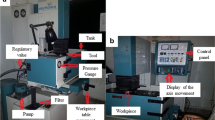Abstract
The material removal rate (MRR), along with the electrode wear rate (EWR), plays an important role in analysing machine output during electrical discharge machining. This work focuses on the improvement of machine output by introducing an induced magnetic field on the workpiece during rotary electrical discharge machining (REDM) of EN-8 steel with a rotary copper electrode. The workpiece was placed inside the induced magnetic field, wherein polarity of the magnetic field gets reversed periodically. Using Taguchi’s recommended design of experiments, we initially conducted experiments with eight input parameters at different levels . Significant parameters were identified with the help of the signal-to-noise ratio and ANOVA. Finally, another set of experiments was conducted for analysis of the process and development of empirical expressions for MRR and EWR. Experimental results established that rotary electrical discharge machining with a polarity reversal magnetic field delivers better machining output than machining in a non-magnetic field. Thus, this work benefits the EDM process by reducing the machining costs and by producing better geometrical trueness on workpieces, as MRR increased and EWR decreased.
Similar content being viewed by others
References
Singh A, Ghosh A (1999) A thermo electric model of material removal during electric discharge machining. Int J Mach Tools Manuf 39:669–682
Pandey PC, Jilani ST (1986) Plasma channel growth and the resolidified layer in edm. Precision Engineering 8(2):104–110
Soni JS, Chakraverti G (1996) Experimental investigation on migration of material during edm of die steel (T215 Cr 12). J Mater Process Technol 56:439–451
Faruqui MA, Mishra P (1978) Studies on the effect of superposition of hydrostatic pressure in electric discharge machining. Proc. of the 8th AIMTDR conf. IIT - Bombay, pp 526–529
Soni JS, Chakraverti G (1994) Machining characteristics of titanium with rotary electro-discharge machining. Wear 171(1–2):51–58
Sato T, Mizutani T, Yonemouchi K, Kawata K (1986) The development of an electro discharge machine for micro hole boring. Precision engineering 8(3):163–168
Guu YH, Hocheng H (2001) Effects of workpiece rotation on machinability during electric discharge machining. J Mater Manuf Process 16(1):91–101
Soni JS (1994) Microanalysis of debris formed during rotary EDM of titanium alloy (Ti 6Al 4V) and die steel (T215 Cr 12). Wear 177(1):71–79
Soni JS, Chakraverti G (1994) Machining characteristics of titanium with rotary electro-discharge machining. Wear 171(1–2):51–58
Ghoreishi M, Atkinson J (2002) A comparative experimental study of machining characteristics in vibratory, rotary, and vibro-rotary electro-discharge machining. J Mater Process Technol 120:374–384
Chow HM, Yan BH, Huang FY (1999) Micro slit machining using electro-discharge machining with a modified rotary disk electrode (RDE). J Mater Process Technol 91:161–166
Yan BH, Wang CC (1999) The machining characteristics of Al2O3 / 6061Al composite using rotary electro discharge machining with a tube electrode. J Mater Process Technol 95:222–231
Wang CC, Yan BH (2000) Blind hole drilling of Al2O3 / 6061Al composite using rotary electro-discharge machining. J Mater Process Technol 102:90–102
Mohan B, Rajadurai A, Satayanarayana KG (2002) Effect of SiC and rotation of electrode on electric discharge machining of Al-SiC composite. J Mater Process Technol 124:297–304
Mohan B, Rajadurai A, Satayanarayana KG (2004) Electric discharge machining of Al-SiC metal matrix composites using rotary tube electrode. J Mater Process Technol 153–154:978–985
Lahiri BN, Mishra PK, Bhattacharya A (1978) Magnetic fields affects crater shapes in spark erosion process. Proc. of the 8th AIMTDR conf. IIT - Bombay 530–533
de Bruijn HE, Pekelharing AJ (1978) Effect of a magnetic field on the gap cleaning in EDM. Annals of CIRP 27(1):93–95
Singh S, Maheshwari S, Pandey PC (2004) Some investigations into the electric discharge machining. J Mater Process Technol 149(1–3):272–277
Wang PJ, Tsai KM (2001) Semi empirical model on work removal and tool wear in electric discharge machining. J Mater Process Technol 114:1–17
Author information
Authors and Affiliations
Corresponding author
Rights and permissions
About this article
Cite this article
Chattopadhyay, K.D., Satsangi, P.S., Verma, S. et al. Analysis of rotary electrical discharge machining characteristics in reversal magnetic field for copper-en8 steel system. Int J Adv Manuf Technol 38, 925–937 (2008). https://doi.org/10.1007/s00170-007-1149-y
Received:
Accepted:
Published:
Issue Date:
DOI: https://doi.org/10.1007/s00170-007-1149-y




